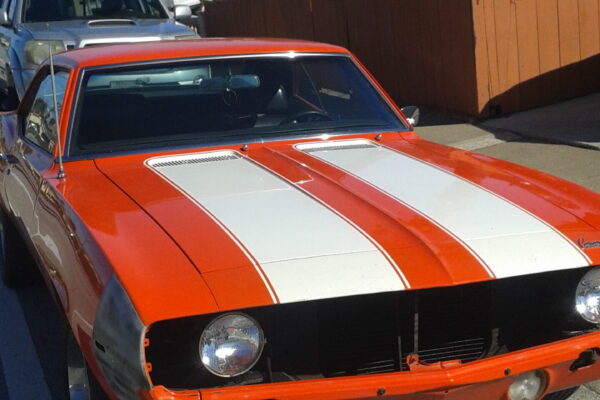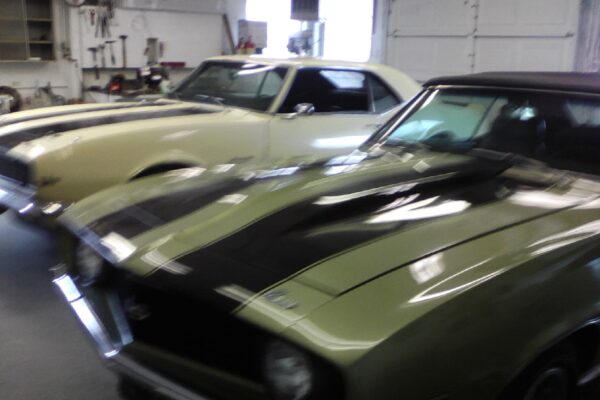Camaro
1st gen to 6 gen


Pulling Out The Stops On A ’69 Camaro With Baer Brakes
https://www.streetmusclemag.com/tech-stories/brakes-suspension/pulling-out-the-stops-on-a-69-camaro-with-baer/
Backpacking
https://www.the-backpacking-site.com/
The best laptops in 2022: 20 top picks tested and tested.
How to Learn SEO In 2022
(In Record Time)
https://backlinko.com/learn-seo-fast
10 Steps to Start Your Business – SBA
Best video conferencing software for 2022https://www.techradar.com/best/best-video-conferencing-software

Authenticating Your Muscle Car
https://www.motortrend.com/news/authenticating-your-muscle-car/
The best laptops in 2022: 20 top picks tested and tested.
https://www.tomsguide.com/best-picks/best-laptops
77 chey 383 stroker A/T nice driver for sale $25000 650 898-5678 Joe
This Camaro LT5 Build Is The Absolute Best Of Both Worlds

This Camaro LT5 build by Stielow Engineering is putting GM’s supercharged 6.2L LT5 V8 engine into a first-gen Chevrolet Camaro, while keeping meticulous attention to detail.
The Camaro LT5 is an all-out build, and the car’s all original sheet metal is getting the full treatment. The engine is backed by a beefed-up T56 Magnum transmission, which D&D Performance outfitted with a 2.66 first-gear, revised synchronizers, and brass sliders. It has big Brembo brakes and the like, but it doesn’t end there, as this build also features a fair bit of fabrication.“This should be a cool build. Love the GM crate motors. I’m going to lean on this one a bit because I know we can make 900 hp easy,” says the builder, Mark Stielow. Of course, “easy” is relative. This builder has a knack for working with metal in meticulous detail, and is actually a GM engineer. He knows a thing or two about building fast Camaros, too, as he was the project manager for the fifth-gen Z28 model.
As for the ability to solve problems, well, take a look at how Stielow maneuvers the clutch-pedal obstacle of the Camaro LT5 build,
I mock it up on my table to sort that out.
Copying the stock 4th gen geometry should make the linkage at a 90 degree angle at 1/2 stroke. It you draw a line from the pivot point of the pedal to the pivot point of the rod end the to the center of the master cylinder it should be 90 degrees. This keeps the side load on the master cylinder to a minimum. If you are failing master cylinders most likely your geometry it incorrect and your side loading the master cylinder.
While you have the assembly out of the car and on the work bench also verify the push rod is straight. The centerline of the master cylinder and the push rod should be straight at half stroke. In my setup I had to add two washers to straighten it up.
I later tack welded the washers on the pedal to make it easier to assemble later.
Immediately after seeing this first-generation Chevrolet Camaro LT5 build, we hopped on Craigslist to see how hard (or easy) it’d be to find a 1967 to 1969 Camaro for sale. We were able to find a few obtainable examples, including a family-owned 1968 model. It looked like a fantastic donor car for an LT5 swap. Regarding pricing, well, at $20,000 the car was more affordable than the powertrain, which costs about $25,000 between the engine itself, accessory drive system, and controller kit.
Of course, the level of ingenuity and craft you see in this Camaro LT5 build is priceless.
One really can’t go wrong when pairing a ZR1 powerplant with a classic Camaro, but this first-gen Camaro LT5 is quickly becoming one of our favorite builds. And that’s saying something, because the internet is full of ’em.
We’ll have more on all things Camaro soon, so be sure to subscribe to GM Authority for more Camaro news, Chevrolet news, and around-the-clock GM news coverage.
LS7 swap by Mark Stielow
Finding Out What It Takes To Stuff An LS7 Crate Motor In An Early Camaro, Dry-Sump And All.A year ago, when we dropped an LS7 into the HOT ROD Solstice, that crate engine was relatively new, and there weren't very many in the hungry hands of the public. But in the time since, GM Performance Parts has sold a bunch of the LS7 crate engines-pretty impressive considering the fairly high street price that hovers around $13,000 (though the list price is $17,000). But the engine (PN 17802397 at your local GMPP dealer) is worth it.
The LS7's parts list reads like a high-end endurance racing engine, with titanium rods and intake valves, CNC-ported heads, offset rockers, and a dry-sump oiling system. With 427 ci and 505 hp out of the box, this is one heck of a package. And as you may have seen in our exclusive dyno test in the Feb. '06 issue, a cam-and-header swap makes it an easy 580hp engine-600 if you want to lean on it. And that's with OE-spec durability. Wow.
As fun as the Solstice project was, we wanted to see what was involved in dropping the engine into a car more representative of the readers of HOT ROD. And what car is more common than a first-gen Camaro? It just so happened that GM Performance Division Engineer Mark Stielow was doing just this swap on his own time: sticking a box-stock LS7 crate motor in his latest Camaro project, a '69 code-named Camaro X. Stielow is known for building first-gen Camaros with wild engines using either oddball cylinder heads or multiple turbochargers, but that was before the LS7 debuted, and now it's a no-brainer for his car. Stielow says, "The goal for Camaro X was to build a fast car, but one that has the driveability and performance of a Z06 Corvette."
Of course, the external architecture of the Gen I (traditional small-block) and Gen III/IV (LS-series) engines is completely different, so it didn't look to be a drop-in engine swap. But thanks to a few parts from American Touring Specialties (ATS), it turned out to be just that. ATS supplied the motor mounts, headers, an oil pan, and a transmission crossmember to allow an F-body T56 six-speed to fit. The company also supplied a hydraulic clutch slave cylinder mount. The engine mounts, oil pan, and transmission mounts made the engine and transmission a bolt-in deal, and the only hole that needed to be cut was for the shifter to come through the floor. The next potential problem area was the dry-sump system, with its plumbing and remote oil tank. Stielow used a Peterson 2-gallon tank and mounted it where the battery used to be.The first step of the swap was to test-fit the accessory drive, headers, and MSD engine-wiring harness. The MSD harness for the MEFI4 engine controller is a true plug-and-play deal. It is terminated for all the stock GM sensors and includes extra sensors and adapters to read fuel pressure at the fuel rail and oil temperature.
With the engine in the car, the next hurdle was figuring out how to make it run-a significant problem considering the LS7's throttle-by-wire arrangement. Adapting a stock wiring harness would be a nightmare, and though GMPD is working on standalone controllers for its line of late-model crate engines (see the sidebar "Controllers to Come"), a unit wasn't available when we were doing this story. Thankfully, MSD has just come out with a killer MEFI4 controller and a mechanical throttle body to allow the engine to work in just about any application. By converting the engine to the MSD EFI system, you no longer need the throttle-by-wire throttle body or the stock mass airflow meter, and MSD's InGenius software allows full control of the system's calibrations. The system comes with an engine calibration that will start and run the engine, but for the best performance (especially if you've thrown in a different cam and/or added headers), you should fine-tune it to the application.
The fuel system consists of a bolt-in stainless fuel tank from Rick's Hot Rod Shop and an in-tank Walbro pump. The LS7 uses a returnless fuel system, so the stock Corvette regulator (PN 10299146) is mounted back by the tank and sends 58 psi of fuel pressure to the stock LS7 injectors. The last thing to button up was the exhaust system, which consists of ATS's stainless steel tri-Y headers and a Stainless Works 3-inch exhaust system, installed by Stenod Performance.
So how does it run? Well, it's wintertime in Detroit (where the car is) as we write this, so Stielow doesn't have any numbers on it yet. But, he says, "Based on the power and weight compared to my other cars, it should run 11.90s at about 120 mph." As with every Stielow-built car, that performance should come on stiff, road-racey suspension and low-profile tires. You could certainly build an 11-second car much cheaper with a traditional small-block and a carburetor, but you'd be hard pressed to match the driveability, mileage, and durability of the LS7 crate engine.
Controllers To ComeWhen this engine swap was happening, GM Performance Parts didn't have an EFI controller for the LS-series crate engines, but it does now. PN 19166567 is a new GMPP plug-and-play controller for the LS7 (PN 19166568 for the LS2). Unlike the MSD controllers, these are nonprogrammable units, meaning they come with the factory tune for the production engine. GMPP is looking into releasing programmable units for the entire LS crate-engine family, but the company doesn't have them yet. For more information on the GMPP controller, check out page 298 of the current 2007 catalog or log on to www.gmperformanceparts.com.
My Story
Near industrial city of so san francisco near oyster point .When I was 10 years old my love for muscle cars was my life. My favorite is 1967 GT500 shelby mustang i knew i was car lover , over the years i had owned 5 mustangs .I developed skills to familiarize myself with all the parts an what it took to restore my cars, back to better than original condition an my passion for collector cars is still part of my life today.
Where I’ve Worked
stewart chev
S&C ford dearship
Brotherhood of electric local #6



Ready to take the next step and work together?
NOS/OE used parts
For custom parts an hardware for advance builds contact me.
Offenhauser Intake manifold race 5715...square port BBC.$1900***
Edelbrock pontiac dual quad w/afb comp carbs .$1300***Dodge T/A challenger 1970 pistol grip shifter assemble survivor $390***










